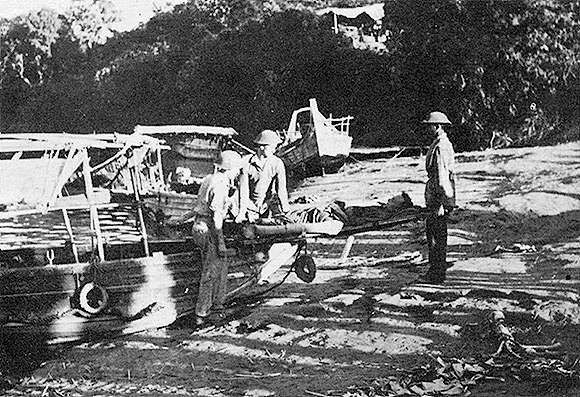A Medical Report By Dr. D Harrison
Annex L
This report was written by Dr Harrison who served with 21 Column.
Medical Personnel
The RAMC Orderlies were exceptionally good throughout the campaign and did their work cheerfully all the time. They were well trained and, more important, were tough enough to help along their weaker brethren. The number of orderlies is inadequate to cope with the mass of minor ailments. There is enough work for eight of them. One each to Adv. Pl., Adv. Col., Commando Pl., Coy. HQ., Reece Pl., (when operating independently) and Support Pl., remaining two with MO in Rear Coln.

Cpl Scott, 1 Queen's is evacuated by sampan
Medical Equipment
Both panniers and contents were excellent. Supplies were dropped promptly and in good condition. Suggest that container with medical supplies be marked with distinctive streamer.
Marching Hours
Sometimes severe strain was imposed on the men by repeated marching 'outside office hours', in enthusiasm to get an extra few miles on the way. This is bad military economics, as men who have before them the prospect of months of marching cannot be expected to pull out something extra continually without physical ill-effects. If forced marching is necessary and the men are told why they have to tear along, they will do it with good heart. But forced marching during a prolonged campaign, except very occasionally, paves the way to lowered resistance and ill health.
The average soldier does not mind a very early start to the day's march, but a full mid-day halt and a daylight bivouac are very essential to good health and morale.
Packs
For carrying the regulation kit, the normal web pack is bad. A well fitting light frame pack would increase marching efficiency by about 100%.
Rations
The 'K' ration with the usual supplementary items is a very good one. But towards the end of the campaign, it lost some of its pristine attractions. Tinned fruit was not much appreciated as usually it had to be eaten in a great hurry after each S.D. Fresh fruit, more bread and onions would improve things, and all possible use should be made of chances to buy food, especially vegetables, from villages. During the campaign there were no cases of malnutrition seen.
Sickness
Up to the Chindwin crossing the, sick rate was very low. Six unfits were sent back in the first two days, and eight were evacuated during the next seven weeks, including four wounded. During this period there were isolated cases of malaria, most of them probably relapses. From when the Column arrived in 'Aberdeen' to the end of the campaign, approximately fifty sick were evacuated, mostly fevers and physical exhaustion. At all times there were plenty of minor injuries and sick, most of which responded rapidly to treatment. There were two small outbreaks of diarrhoea, both of which cleared up in four or five days. The intelligent use of Medical Haversacks by Group Commanders was done well and cut down the work of the Medical Orderlies considerably.
Suppressive Mepacrine
Proved its worth. The importance of taking it was impressed on the men ad nauseam, and after they had seen the trials and tribulations of a few cases of malaria, they were completely converted. The taking of the tablets must be enforced very strictly. It was a striking fact that most of the men who did get malaria were the less efficient types who spend a large proportion of their lives dodging one thing or another. I believe that mepacrine can keep the incidence of malaria to an absolute minimum. Probably one tablet every other day is sufficient. Each man's monthly supply should be carried in a strong tin, not the Indian effort which was often broken in dropping and had an amazing aptitude for springing open at the wrong time.
Water Discipline
With the exception of the few bloody fools, water. bottles were always sterilised before drinking. This was simple when sterilising tablets were available, but quite impracticable with the powder.
Ponies
The good ones thrived and did some grand work carrying sick and wounded, whilst the bad ones died. A minimum of six ponies should travel behind the Medical Section in Rear Coln. The casualty saddle supports looked fine, but usually broke as soon as the patient tried to relax on them. Mules are better than ponies for carrying sick men's packs.
Air Evacuation
Was beyond all praise. At the appointed time and place the planes invariably arrived and patients were loaded and taken off without fuss. To see a badly wounded man soar from a strip of jungle paddy towards hospital and safety was one of the more exhilarating sights of the campaign. One suggestion - light planes to carry blankets and pillows.
The general health of the Column was amazingly good up to the Chindwin when it deteriorated somewhat, until we reached 'Aberdeen'. A short rest there, eased the situation temporarily, but on resuming the march it soon became obvious that many of the men were becoming increasingly weary, despite occasional 24 hour bivouacs.
A long rest at 'Aberdeen' revived the Column temporarily, but right up to the end of the campaign their reserve of energy was low and the Column as a whole were not 100% 'fighting fit'. To have crossed the Naga Hills carrying such heavy loads was a big physical achievement, but it made inroads into the average man's health and vitality, affecting his entire reactions during the remainder of the campaign.
D Harrison. Capt. RAMC
29/5/44. MO 21 Coln., 2nd Battalion, The Queen’ s Royal Regiment.
Related
